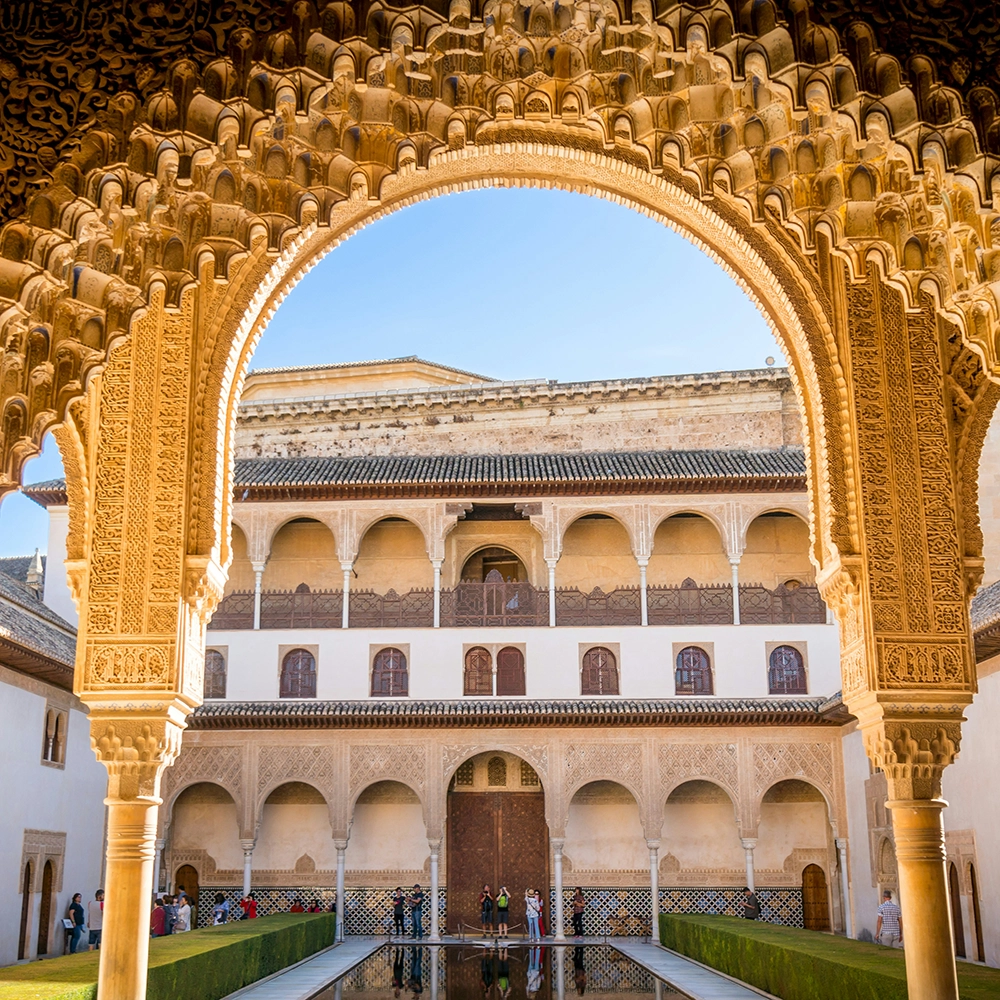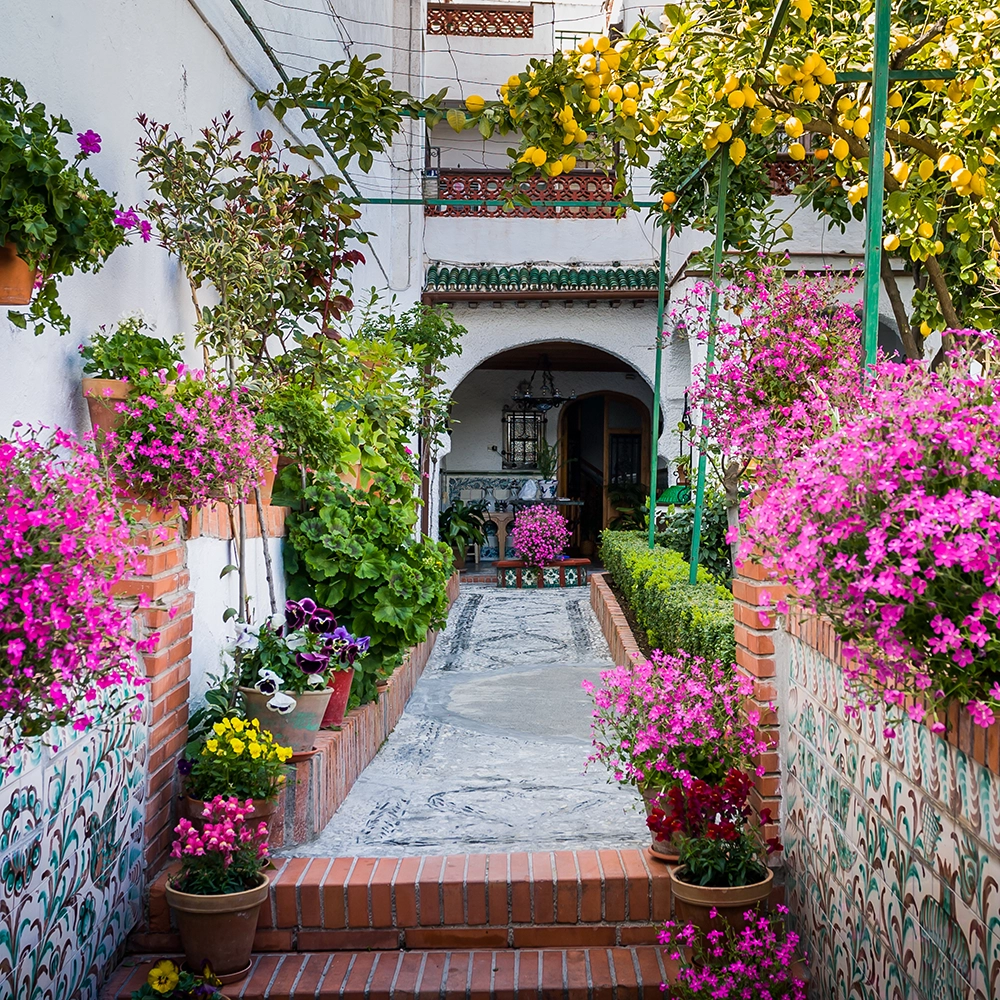"Why Granada?”
That’s typically the first question I hear when I talk about the six months I spent in Spain. No matter how often I’m asked, I never know where to begin. In part, I chose to go to Granada because I wanted to put my Spanish minor to use. But I also wanted to get a better understanding of my own place in history and culture.
For anyone dreaming of their own Andalusian adventure, start with this guide to Granada to make the most of your experience.
Where is Granada, Spain?
Granada is in southern Spain, in Andalusia. It’s in the mountains but still only about 45 miles (70 kilometers) from the closest beach.
Its location explains a lot about the city’s people, culture, and natural attractions. Granada is actually closer to Africa than it is to Madrid in the center of the country, hence the Moorish influence you see most obviously in the city’s architecture and the Arabic sounds you’ll hear in the local dialect.
Granada sits on the outskirts of the Sierra Nevada mountains. These foothills made it a favorite site for constructing fortresses; what better location for the Alhambra than on literal high ground?
It’s those mountains, along with close proximity to Mediterranean beaches, that make it a favorite for nature lovers.
In the months that I spent exploring Granada, I found that it was the perfect city for a new traveler like me. It was big enough to offer a wide range of activities, but small enough for me to master public transportation within a few days.
Its balance of rich history and contemporary culture kept me inspired throughout my stay, and the nearby mountains and beaches offered a wealth of outdoor options. While I certainly missed American food and culture toward the end of my stay, there was something to be said about being surrounded by so much beauty.
Things to Do in Granada, Spain
With a blend of Muslim, Jewish, and Christian roots, Granada was a melting pot before the term became popularized. Today’s Granada maintains a strong connection with history. Arabic architecture blends with European cobblestones to create a city brimming with character.
As a history buff, I found that the stories told by local guides and by the city fabric made it a perfect destination. But perhaps the most characteristic element of Granada was its local culture — one that celebrates art, simplicity, and joy.
As an overworked, anxious college student, I wondered if the laidback Andalusian lifestyle was just a stereotype. I was delighted to find that it wasn’t. After six months of living, studying, and working in Granada, I found that it was an ideal home-away-from-home.
As a temporary local, here are my top recommendations for what to do in Granada, Spain.
1. Alhambra Palace
Any article about Granada has to mention the Alhambra. Originally built in 899 A.D. before being renovated in the 13th century, the Alhambra Palace in Granada, Spain, is an ornate fortress that once housed the political elite. It was intended to be a “paradise on earth” for those who lived there, and even today, that original splendor remains.
Detailed mosaics offer bursts of color among the rooms, while intricate stonework contains swirling Arabic phrases, all giving glory to Allah.
Although the Alhambra is quite clearly a fortress, it holds a degree of softness that’s often missing in other European fortresses. Sunlight and breezes pass easily through the Alhambra’s soaring rooms, and fruit trees and fountains decorate the interior gardens.
The dizzying beauty of the Alhambra attracts visitors from around the world. Today, the palace is a UNESCO World Heritage site and one of Spain’s most popular attractions.
2. Albayzín neighborhood
While nothing can quite compare to the splendor of the Alhambra, Granada’s Albayzín is the perfect place to discover local culture.
This historic neighborhood maintains the narrow, winding streets that first shaped modern Granada, inviting visitors to get lost in the city’s past.
As you wander, you may stumble across a small square with a bubbling fountain, a lively street performer, or a hole-in-the-wall restaurant where you can sample the most authentic local food. Explore artisan markets to buy tea, clothing, and leather goods.
Then try soaking in heated pools at an Arabic bath. Indulging in aromatherapy and massage at these centuries-old spas is an experience you won’t regret.
Of course, no trip to the Albayzín is complete without visiting the nearby Sacromonte district to watch a traditional Flamenco performance.
3. La Semana Santa
One of my most memorable experiences in Granada was celebrating La Semana Santa, or Holy Week. In the days leading up to Easter, the city streets were filled with processions representing Christ’s life and final days on Earth.
Volunteers from local church groups carried ornate floats throughout the city, each bearing life-sized statues of Jesus, Mary, and the saints.
Depending on the night, the celebrations were accompanied by the rattling of chains, the burning of incense, or the blaring of trumpets, each with its own symbolism. Music and somber colors serve as a powerful reminder of Spain’s Catholic traditions.
Beyond La Semana Santa, Granada is home to a number of lively festivities year-round. From the city-wide feria del libro (essentially, a book fair on steroids), to the feast of Corpus Christi to the Granada Festival of Music and Dance there are countless opportunities to celebrate Granada’s culture and heritage.
4. Art scene
While Granada is rich in history and tradition, it’s also a city brimming with innovation and creativity. It’s one of the top Erasmus destinations in Europe, drawing university students from around the world to live and study for months at a time.
What’s more, the city has an unmistakably “hippy” vibe. It’s not uncommon to see drum circles, harem pants, and bare feet as you stroll through the streets.
Mixed among Granada’s ancient buildings and historic streets are enormous murals by local artist, El Niño de las Pinturas. These murals seek to capture the wonder of childhood and are tucked in lesser-known parts of the city, turning a stroll through the streets into an art lover’s scavenger hunt.
5. Tapas
One of the best parts about living in Granada was the opportunity to sample Andalusian food. Tapas are bite-sized servings of different kinds of food — think Costco samples, but fancier.
In Granada, most local bars offered tapas for free with the order of any drink, and they often turned out to be larger portions than the tapas in other parts of Spain. During my time abroad, I could order a few drinks over the course of a night and make a dinner out of the tapas provided.
What’s more, the tiny samples I received — patatas bravas (potatoes), setas slateadas (fried mushrooms), carrillada (saucy, stewed pork) — were a perfect introduction to classic Spanish cuisine. If you’re as passionate about snacks as I am, Granada should be at the “tapa” your travel bucket list.
How to See the Best of Granada, Spain
There’s a saying that’s often quoted by local Granadinos and tourists alike: no hay en la vida nada como la pena de ser ciego en Granada. Roughly translated, it means “there’s nothing sadder in life than to be blind in Granada.”
Once you see Granada for yourself, there’s a good chance you’ll agree.
When you’re ready to see this incredible city, make sure you’re ready in every way possible. From study abroad packing lists to travel insurance for Spain (whether you’re a student or not) to finding cheap flights to Europe, Seven Corners can help you enjoy the trip of a lifetime.
Find more tips at SevenCorners.com.



